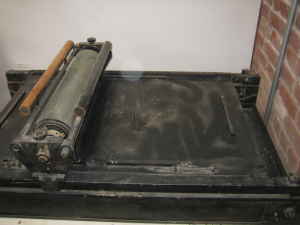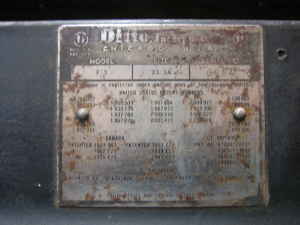Ditto Press
I’ve come across a Ditto Press for sale and can’t find any information online about it. It needs a lot of work and some parts, but I’d be willing to invest time in it. Does anyone know about these presses? Here’s the information on the name plate:
Ditto Incorporated
Chicago, USA
Model F-5
Size 22 - 34
Serial No 6984
Thanks!

3k83of3pa5Q05P65Rd99b02f57b4dfeb11d34.jpg

3kb3m03p65Of5Q05P999be47ecdbe701e1f6f.jpg

3n03me3pf5Q55P05Sa99b875addbf4eeb1b8e.jpg
I remember Ditto machines as rotary stencil duplicators, but your picture shows something else. Is the distance from bed to cylinder type-height? Is the cylinder rubber-covered? If so, it might work like a sign press. But if the gap is small, and the cylinder is ink-retaining material, it might be for flatbed stencil work. Just a guess.
I don’t remember Ditto making a stencil machine, they made “spirit duplicators”. The later models were similar to mimeographs, but used a sheet of coated paper with a wax image consisting of dye which would transfer to a sheet of paper dampened with methanol. Smelled wonderful.
The model pictured here may be the one mentioned in this article, a flat-bed machine (the photo did not download to the site, so I couldn’t compare them.:
“Beginning in 1910, Ditto, Inc., sold gelatin duplicators that were essentially large mechanical versions of the Daus Tip-Top Duplicator pictured to the right. The Ditto process could be used for up to 100 copies. Plate 34A is a 1925 Ditto machine. “When preparing the original, hard bond paper and a special kind of ink [containing aniline dyes] are used. This may be in the form of a duplicating typewriter ribbon, a duplicating ink, or even an indelible pencil. The original is placed face down on the copying surface and smoothed with the palm of the hand or a roller. It is then lifted off, having left its impression on the gelatin. The blank sheets are placed one at a time on the gelatin surface and allowed to remain a few seconds until the imprint is made.”
http://www.earlyofficemuseum.com/copy_machines.htm
John Henry is right on about the classic Ditto machines being “spirit duplicators”, not stencil (Mimeograph) duplicators. I bet a lot of us remember our grade-school teachers handing out those purple “dittoed” sheets, fragrant from being freshly run off!
I don’t think the Ditto press pictured above could be one of the gelatine duplicators John mentions. Those were known as hectographs, and the ones I’ve used were just simple lightweight sheetmetal trays filled with gelatine, not a heavy base with a roller mechanism. And since no real pressure is needed to make a print on a hectograph, just good contact between gelatine and paper (hence the “smoothed with the hand”), the roller setup on the press above would be overkill to say the least.
Can you set type into the bed (either in a chase or on a galley) and still have the impression cylinder roll over it???? If so, you probably have a letterpress proof press of some sort. In looking at the picture, it is hard tell if the distance from the bed to the impression roller will allow type to be imprinted on that machine.